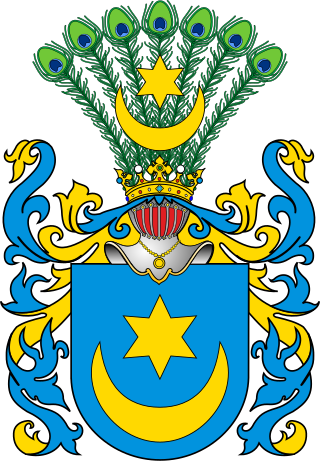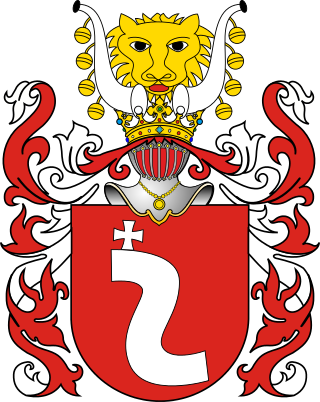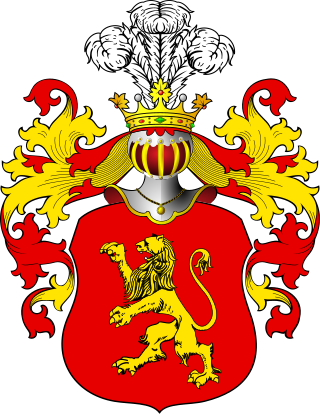| Czarnowron | |
|---|---|
 | |
| Details | |
| Alternative names | Ślepowron variation Czarnowron |
| Families | Borowicz, Fijałkowski, Fiałkowski |
Czarnowron is a Polish coat of arms. It was used by several szlachta families.
| Czarnowron | |
|---|---|
 | |
| Details | |
| Alternative names | Ślepowron variation Czarnowron |
| Families | Borowicz, Fijałkowski, Fiałkowski |
Czarnowron is a Polish coat of arms. It was used by several szlachta families.
| | This section is empty. You can help by adding to it. (July 2010) |
| | This section is empty. You can help by adding to it. (July 2010) |
Notable bearers of this coat of arms include:

Nałęcz is a Polish coat of arms. It was used by associated szlachta families in the Kingdom of Poland and the Polish–Lithuanian Commonwealth (1569–1795).

Sulima is a Polish coat of arms. It was used by several szlachta families in the Kingdom of Poland and the Polish–Lithuanian Commonwealth. Notable people using the symbol were Zawisza Czarny—a famous Polish knight—and the Sułkowski family.

Jastrzębiec is one of the most ancient Polish coat of arms. Dating back to the 10th century, it has been used by Poland's oldest szlachta families — Poland's Immemorial nobility — and remains in use today.

Leliwa is a Polish coat of arms. It was used by several hundred szlachta families during the existence of the Kingdom of Poland and the Polish–Lithuanian Commonwealth, and remains in use today by many of the descendants of these families. There are several forms of the arms, all of which bear the name, Leliwa, but which may be distinguished as variations of the same arms by the addition of a Roman numeral. In 19th century during a pan South-Slavic Illyrian movement heraldic term Leliwa also entered Croatian heraldry as a name for the coat of arms considered to be the oldest known symbol; Bleu celeste, a mullet of six points Or surmounted above a crescent Argent – A golden six-pointed star over a silver crescent moon on a blue shield, but also as a name for all other coats of arms that have a crescent and a mullet.

Topór is a Polish coat of arms. It was used by several szlachta (noble) families in medieval Poland and under the Polish–Lithuanian Commonwealth.

Srzeniawa is a Polish coat of arms. It was used by several szlachta families in the times of the Kingdom of Poland and the Polish–Lithuanian Commonwealth.

Rawa (Rawicz), is a coat of arms of Polish origin. It was borne by several noble families of Polish–Lithuanian Commonwealth, Russian Empire and Ukraine.

Łodzia is a Polish coat of arms. It was used by many noble families of the Kingdom of Poland and the Polish–Lithuanian Commonwealth. A variant serves as the coat of arms of the city of Łódź. It's a classic example of the so-called canting arms well known in European heraldry as it was borne by the medieval lords de Łodzia and their clan. Hence the boat in the shield, clearly alluding to the estate's name literally meaning Boat. Coats of Arms in the Polish Lithuanian Commonwealth were a symbol of a heraldic clan.

Polish heraldry is the study of the coats of arms that have historically been used in Poland and the Polish–Lithuanian Commonwealth. It treats of specifically Polish heraldic traits and of the Polish heraldic system, contrasted with heraldic systems used elsewhere, notably in Western Europe. Due to the distinctive ways in which feudal societies evolved, Poland's heraldic traditions differ substantially from those of the modern-day German lands and France.

Herburt is a Polish coat of arms. It was used by several distinct and unrelated szlachta families such as the Pawcz family of Ruthenian Galicia. A coat of arms is an individual or family heirloom the origins of which lie in the 12th century.

Wieniawa is a Polish coat of arms. It was used by several noble, in Polish language szlachta families in the times of medieval Poland and the Polish–Lithuanian Commonwealth.

Niesobia, is a Polish coat of arms. It was used by several old szlachta families in the times of the Polish–Lithuanian Commonwealth.

Brochwicz is a Polish coat of arms. It was used by several szlachta families.

Drużyna is a Polish coat of arms. It was used by several szlachta families in the times of the Kingdom of Poland and the Polish–Lithuanian Commonwealth.

Pilawa is a Polish coat of arms. It was used by many noble families known as szlachta in Polish in medieval Poland and later under the Polish–Lithuanian Commonwealth, branches of the original medieval Piława Clan (Pilawici) family as well as families connected with the Clan by adoption.

Ryc is a Polish coat of arms. It was used by the Ryc and Rydz szlachta families.

Piłsudski is a Polish coat of arms. The Piłsudski family, whom belonged to the Polish nobility (szlachta), used it.

Iwanowski is a Polish coat of arms. It was used by the Iwanowski Polish noble family.

Kur II is a Polish coat of arms. It was used by several szlachta families in the times of the Polish–Lithuanian Commonwealth.

Lew II - Polish coat of arms, used by several genera. Two of them were families from the region of Kaszuby. Coat of arms "Lew II" is a variant of the coat of arms "Leo".